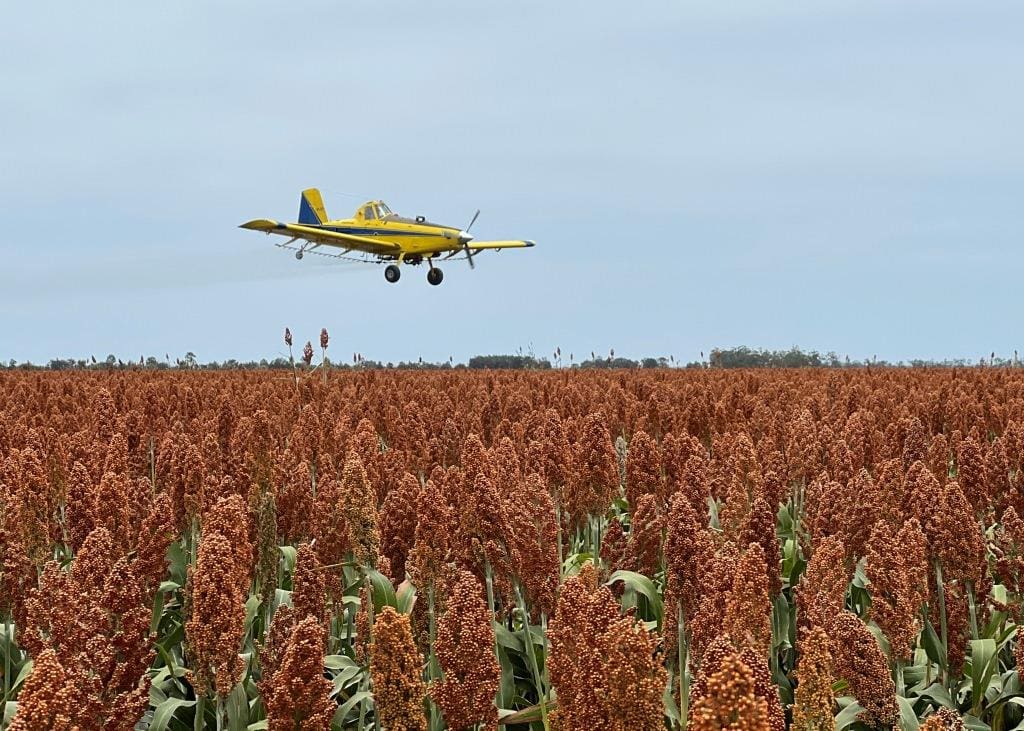
Desiccation and harvest of early sorghum is under way in districts including Pallamallawa. Photo: Sam Gall, Pioneer Seeds territory sales manager for Liverpool Plains and north-west NSW
PRICES for feedgrain have eased in the northern market this week as growers quit barley and SFW wheat to make room for a bumper sorghum harvest knocking on the door.
In the south, growers have limited interest in selling at current values, and most activity is occurring within the trade.
This includes some up-country consumers swapping out pre-booked ASW wheat for cheaper SFW, with sound grades still making their way into lively export channels.
| Nearby | Change from Jan 13 | |
| Barley Downs | $290 | Steady |
| SFW wheat Downs | $305 | Down $3 |
| Sorghum Downs | $305 | Down $25 |
| Barley Melbourne | $315 | Up $5 |
| ASW wheat Melbourne | $385 | Up $5 |
| SFW wheat Melbourne | $345 | Up $5 |
Table 1: Indicative delivered prices in Australian dollars per tonne.
Northern growers meet market
Consumers in Queensland and northern New South Wales are settling into their ration mix for 2022, with SFW a feature in the poultry and feedlot sectors.
Weather-damaged wheat with specs below SFW and F3 barley at around $200/t delivered is working into rations at some smaller operations.
These, and larger operations too, are buying some faba beans as a high-protein inclusion to help balance profiles in rations that contain rain-affected cereals.
Faba beans grown in Queensland and northern NSW are too far from southern ports to price into bulk shipments, and limited container availability is directing them into the domestic market.
Consumers are seen as having covered their prompt demands, and are now completing their February coverage.
Stewarts Grain trader Robert Quinn said feedlots appear to have switched from barley to SFW wheat, and consumers seem to be well covered for coming weeks.
“I think they’ve bought a bit.”
“The prices for both are about the same delivered feedlots, and everyone’s in a hurry to move it.
“Most of our clients are trying to get rid of wheat and barley to make room for sorghum.”
Early sorghum crops are now being harvested in northern NSW and southern Queensland, and growers are in a hurry to empty their on-farm storages to make way for the red grain which is largely destined for export to China.
In recent days, some parts of northern NSW have received significant rain.
“Most people got 10mm or so, and more missed it than got it.”
Largest northern NSW rainfall registrations in the week to 9am today include: Moree 56mm; Mungindi 43mm; Narrabri 38mm; Quirindi 43mm; Walgett 16mm, and Wee Waa 75mm.
Registrations in Queensland include: Dalby 29mm; Jondaryan 5mm; Macalister 27mm; Pratten 50mm, and Surat 21mm.
The rain will bolster yield prospects for mid and later-season sorghum crops ahead of harvest which for most will start late next month.
Southern growers disengage
The appeal of SFW wheat appears to be growing for consumers in the southern market, who also have plenty of new-crop faba beans available at prices which have been diving when export demand evaporates.
Pearsons Group grain trader Reagan Stroud said the market was quiet.
“It doesn’t feel like a lot is transacting.”
The big rally in US wheat futures over the past two days has put upward pressure on global prices.
“It’s been a significant move for the US, and our basis will cop the brunt of that.”
Much of the wheat and barley being shipped out of south-eastern Australian ports into March is being done on business written late last year, when growers were keener sellers.
Mr Stroud said consumers in up-country Victoria were more interested in SFW wheat from the NSW Riverina than ASW, and this was narrowing the spread between the two grades.
“SFW from throughout the Riverina is appealing.
“If its nutritional profile is equivalent to ASW, and it’s landing in Melbourne at $35/t cheaper, then there’s some interest.”
This could see the trade divert earlier-booked ASW into the export market, provided the trucks are available to bring SFW into Melbourne consumers.
“We’re seeing that around Bendigo now; there’s a lack of interest in ASW.
“It hasn’t transpired in Melbourne yet, and logistics is keeping things tight.”
Road transport is being kept busy in Victoria bringing wheat, barley, canola, lentils and faba beans to export terminals.
“ASW has value in its own right, and as a blend, and there’s plenty of ASW in Victoria.”
Feed barley could be a different story, as a sizeable chunk of the Victorian barley crop made specs for malting.
It is in strong demand for export as is, and from maltsters selling into domestic and export markets.
“Barley is getting harder and harder to buy, but the assumption is there’s plenty around.”
